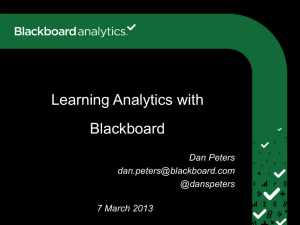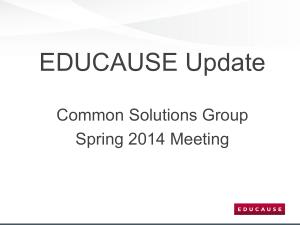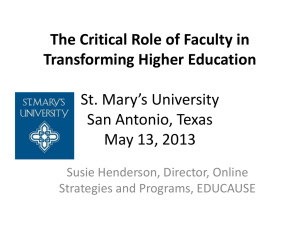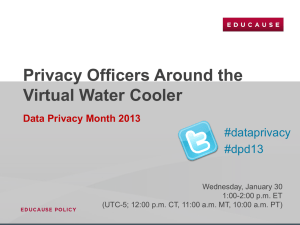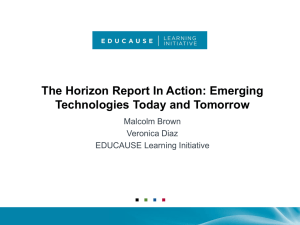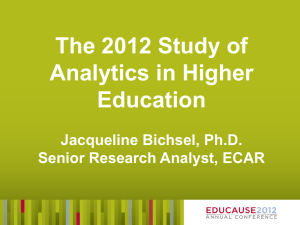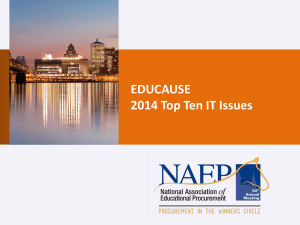ELI Webinar Abbreviated Participant Chat Transcript Using
advertisement
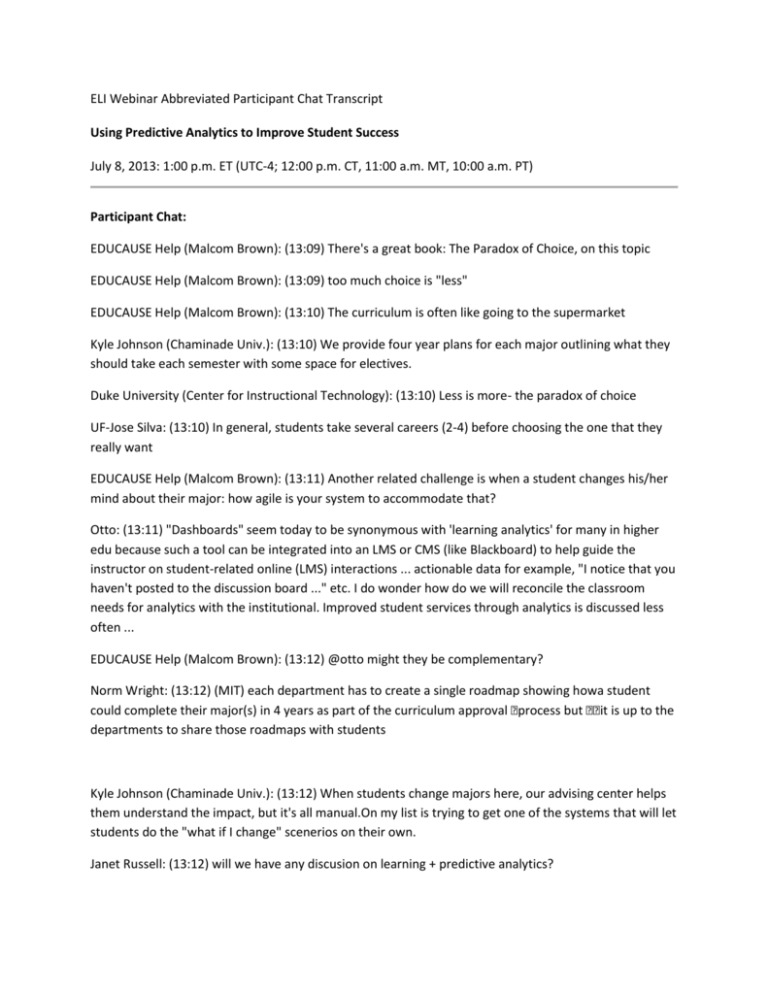
ELI Webinar Abbreviated Participant Chat Transcript Using Predictive Analytics to Improve Student Success July 8, 2013: 1:00 p.m. ET (UTC-4; 12:00 p.m. CT, 11:00 a.m. MT, 10:00 a.m. PT) Participant Chat: EDUCAUSE Help (Malcom Brown): (13:09) There's a great book: The Paradox of Choice, on this topic EDUCAUSE Help (Malcom Brown): (13:09) too much choice is "less" EDUCAUSE Help (Malcom Brown): (13:10) The curriculum is often like going to the supermarket Kyle Johnson (Chaminade Univ.): (13:10) We provide four year plans for each major outlining what they should take each semester with some space for electives. Duke University (Center for Instructional Technology): (13:10) Less is more- the paradox of choice UF-Jose Silva: (13:10) In general, students take several careers (2-4) before choosing the one that they really want EDUCAUSE Help (Malcom Brown): (13:11) Another related challenge is when a student changes his/her mind about their major: how agile is your system to accommodate that? Otto: (13:11) "Dashboards" seem today to be synonymous with 'learning analytics' for many in higher edu because such a tool can be integrated into an LMS or CMS (like Blackboard) to help guide the instructor on student-related online (LMS) interactions ... actionable data for example, "I notice that you haven't posted to the discussion board ..." etc. I do wonder how do we will reconcile the classroom needs for analytics with the institutional. Improved student services through analytics is discussed less often ... EDUCAUSE Help (Malcom Brown): (13:12) @otto might they be complementary? Norm Wright: (13:12) (MIT) each department has to create a single roadmap showing howa student could complete their major(s) in 4 years as part of the curriculum approval •process but ••it is up to the departments to share those roadmaps with students Kyle Johnson (Chaminade Univ.): (13:12) When students change majors here, our advising center helps them understand the impact, but it's all manual.On my list is trying to get one of the systems that will let students do the "what if I change" scenerios on their own. Janet Russell: (13:12) will we have any discusion on learning + predictive analytics? EDUCAUSE Help (Malcom Brown): (13:15) the guy in the maze has no way out going forward! Jay @ CSUSM: (13:15) that guy in the maze is going nowhere ... start over. Otto: (13:15) @Malcolm -- Yes, but I think that there is a recognition that analytics are needed at the local level (classroom) to compete in the long run with more top-down organizations (and MOOCs) that have the ability to guage learning outcomes more rapidly ... Jay @ CSUSM: (13:15) 5-6 year degree completion right there EDUCAUSE Help (Malcom Brown): (13:17) Question: how do you measure the impact that a predictive system is having? Craig Ogilvie (ISU): (13:18) is rating from student-evluation of teaching or from learning games? EDUCAUSE Help (Malcom Brown): (13:21) does global = foundational or are there other factors in global centrality? Norm Wright: (13:21) are these rankings done manually or using some sort of graph of the requirements or based on past students experience? EDUCAUSE Help (Malcom Brown): (13:22) Did Austin P. invent its own grade prediction method? EDUCAUSE Help (Malcom Brown): (13:24) Can the recommendation system make a "stretch" recommendation? Duke Univ, Elizabeth Evans: (13:25) @Malcolm, Ditto your last two questions. Jay @ CSUSM: (13:27) Are predictive grades adjusted based on course-load of students? I.e. if taking full load of difficult courses, expecting lower grades than iffocusing on fewer? EDUCAUSE Help (Malcom Brown): (13:28) the fall-back resource of talking to the advisor is key, it would seem Otto: (13:29) Do you have data on the number of students who engage in an academic advisory session at APSU? VeronicaDiaz: (13:33) another best practice... Otto: (13:34) excellent Jay @ CSUSM: (13:36) are success predictors linked to disciplines? would you expect two students with the same basic SAT, GPA, etc. to have the same success in a math class if one is from the math & sciences major and the other is in the humanities? Does it match types of previous classes/foundations? Christopher Reichley - University of Mississippi: (13:41) Have you measured the impact on 5 and 6 year graduation rates? Otto: (13:44) Very compelling student-centered approach to offer a better experience to the student ... how have your faculty reacted or what has been the feedback from faculty? Norm Wright: (13:46) wow Otto: (13:46) ditto Norm - wow! Bethany: (13:50) Would be interesting to see how this would work with Purdues Course Signals program Norm Wright: (13:51) At MIT the departments know their key classses and have those conversations with students who then say they want to pursue that major despite this.. my guess is the analytics are betterand the student would recieve the message better too if a "machine" calculated that they will have a tough time if they pursue that major despite the flagging... hmmm.... Otto: (13:52) Can the student provide feedback to the system (akin to high marks./stars on Amazon or Netflix) to substantiate or refute the suggested stars from the system? Linda: (13:55) Do you track employment after graduation to determine if students have been employed in their major? Norm Wright: (13:55) can you only get the logic by •purchasing from Desire2Learn?Has this been published an any journals?
